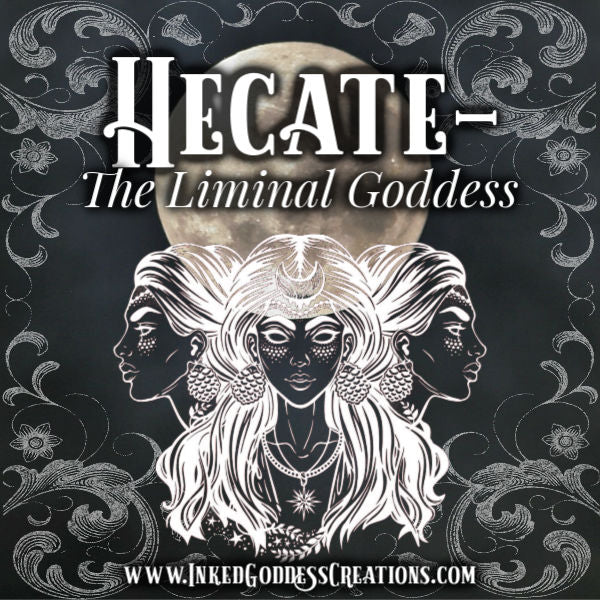Hecate – The Liminal Goddess

For Pagans and witches in the Northern Hemisphere, this time of year is one of liminality (the transitional period or phase of a rite of passage). The promise of spring, the ripening of summer, and the harvest of autumn have passed, but winter will not “officially” arrive until December 21st. This sense of being neither here nor there is reflected in the fact that the veil between this world and the otherworld is particularly thin at the moment. This is the time of Hecate, Goddess of the Night, Goddess of Necromancy & Spirits, and Goddess of Magic, the Moon, & Witchcraft. Her domain includes borders, city walls, doorways, crossroads, and all other places that are “between”.
Some scholars believe Hecate originated in Anatolia, others believe she came from Thrace, while still others insist she is entirely of Greek origin. While there is a set of stories that depict her as a human mortal, rescued from sacrifice by Artemis and transformed into the immortal Hecate, most classical sources (largely translated by Victorian and Edwardian men afflicted by varying degrees of misogyny) assert that she is a third generation Titan, who somehow managed not to annoy Zeus. In fact, Zeus liked Hecate so much that he “allowed” her to keep all of her considerable powers. Among those powers were the giving of wealth, victory, wisdom, good luck to sailors, fishermen, and hunters, and increase to cattle, goats, and sheep. She had the power to take away all these gifts as well. Hecate was also a nurse and protector of children and youth. All of this made her one of the main household deities in Athens, along with Apollo, Hermes, Hestia, and Zeus.
As the daughter of Perses the Destroyer, and Asteria the Starry One, Hecate took on the role of Goddess of the Night. She is depicted in art and literature as bearing torches. Legend has it that she lit the way for Demeter to look for Persephone in the Underworld. Hecate subsequently became Persephone’s companion during her yearly journeys to and from the realm of Hades, which is probably one reason why she came to be associated with necromancy and spirits.
At various times throughout her history, Hecate has been identified, combined, or confused with hunter and wild goddess Artemis, and moon goddess Selene. Given this conflation, in addition to her other powers, it’s not surprising that Hecate became a moon goddess as well as a goddess of magic. The many stories of the great and terrible sorceress, Medea, have her invoking Hecate’s aid, knowledge, and power.
It is as Goddess of the Crossroads that Hecate is most likely to be familiar to modern folk. In this form she is usually depicted as three identical women standing back-to-back-to-back, or around a column. One holds two torches, another holds a key and a snake, and a third holds a sword or a dagger and another torch (or a bowl and a flagon, or a whip). There are a number of these kinds of statues in museums. The torches represent Hecate lighting the way in the darkness; the bowl and flagon symbolize libations to the gods. The snake represents both regeneration and underworld spirits, while the sword or dagger is a symbol of sacrifice. The whip was believed to control spirits, and the key opens the door to Hades.
November 16th is Hecate's Night, starting at sundown. Many witches honor Hecate on this night by having a Hecate Supper where they go to a crossroads with a question, and leave an offering of a plate of food to  Hecate. Once you’ve left your offering, don’t look back – but pay attention to your subsequent dreams.
Hecate. Once you’ve left your offering, don’t look back – but pay attention to your subsequent dreams.
Inked Goddess Creations also has a Hecate Goddess Set that contains a candle, perfume oil, mist, and antique key talisman to help honor and work with the goddess Hecate. Her signature blend of honey, myrrh and cinnamon is sure to resonate positively with this Goddess of the Night.
Author credit: Pictishwitch (written for The Inked Grimoire) with additions by Morgan, Owner of Inked Goddess Creations
